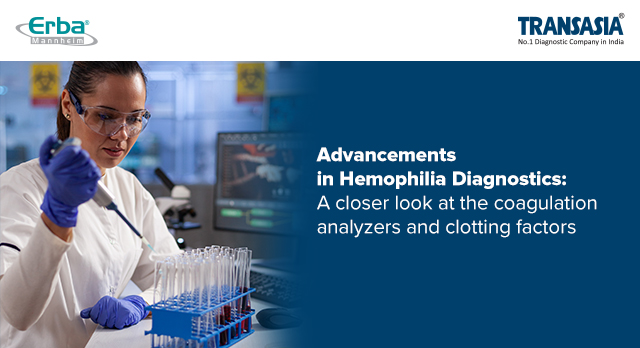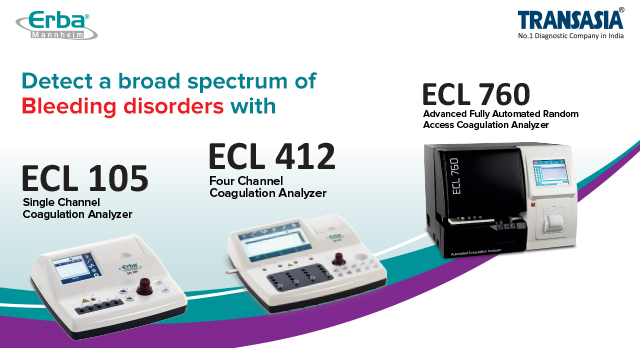Simplified Hemophilia Diagnosis: Innovations in Coagulation Analyzers and Clotting Factors

Hemophilia, a rare genetic bleeding disorder, poses challenges for both patients and healthcare providers. Hemophilia A (HA) and B (HB), caused by the absence or reduction of clotting factors VIII or IX, lead to uncontrolled bleeding. Over 300,000 people worldwide are affected with hemophilia.1
Recent diagnostic advancements enable more precise and personalized treatments. Accurate measurement of factors FVIII or FIX is crucial for comprehensive hemophilia diagnosis and management. The widely used one-stage aPTT-based clotting assay assesses FVIII or FIX activities, while specialized labs offer FVIII and FIX chromogenic substrate assays. The choice of reagent/methodology significantly impacts results.
Role of Coagulation analyzers and clotting factors in diagnosing hemophilia
Coagulation tests are predominantly conducted within hospital-affiliated laboratories rather than standalone facilities. Primary assessments, such as PT and aPTT, encompass 80% of these tests and play a pivotal role in hemophilia diagnoses. The advent of modern and advanced coagulation analyzers has notably enhanced the precision and efficiency of hemophilia diagnostics.
The diagnostic instruments employed for these tests have undergone a transformative journey, progressing from quantifying clots' optical density in cuvettes to detecting clotting factors. These analyzers have evolved incrementally, incorporating diverse technologies within the same apparatus. These advancements encompass optical detection of clot formation, chromogenic substrates, latex agglutination immunoassays, and turbidimetry.
Moreover, manufacturers strategically emphasize systems characterized by high throughput, reliability, and user-friendly advanced software featuring LJ graphs, and calibration curves to minimize errors. Technological progress has translated into heightened capacity, productivity, sensitivity, specificity, and ultimately an elevation in the standard of clinical care for patients.
Modern coagulation analyzers utilize advanced technology to assess the various stages of blood clotting with enhanced precision. These advancements expedite hemophilia diagnosis and contribute to a more tailored treatment strategy by identifying specific deficiencies in the clotting cascade.
Clotting Factors:
Understanding clotting factors is crucial in managing hemophilia, as deficiencies in these proteins lead to impaired blood clotting. Recent developments in clotting factor therapies have revolutionized hemophilia treatment, offering patients improved quality of life and reducing the frequency of bleeding episodes.
Transasia’s offerings in Coagulation Portfolio
Transasia Bio-Medicals Ltd. offers semi- and fully automated coagulation analyzers and innovative and technologically advanced reagents. The product portfolio covers the PT, aPTT, D Dimer, calibrators, and controls. Our advanced range of products includes ECL range of fully and semi-automated coagulation analyzers, ECL 760, ECL 412, and ECL 105, that offer early detection of bleeding and clotting disorders. These analyzers are advanced systems, which redefine existing products in the marketplace. These systems have interactive displays, built-in printers, RFID, cuvette and reagent management systems, elaborate Quality Control software, and up to 6-point multi-standard curve features. These features allow the system to perform various coagulation tests on a semi-automated platform.

The combination of advanced coagulation analyzers and innovative clotting factor therapies marks a significant leap forward in the field of hemophilia diagnostics and treatment. These advancements enhance the accuracy of diagnosis and pave the way for more targeted and personalized interventions, ultimately improving the lives of individuals with hemophilia. As technology evolves, the future holds even more promising developments in the quest for effective hemophilia management.
Reference:
- Treatment Guidelines Working Group on Behalf of The World Federation Of Hemophilia. Srivastava A, Brewer A K, Mauser-Bunschoten E P et al. Guidelines for the management of hemophilia. Haemophilia. 2013;19(01):e1–e47.